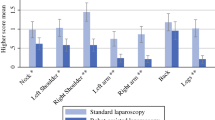Abstract
One proposed advantage of robotic surgery is improved ergonomics and decreased surgeon fatigue. The objective of this study is to quantify and compare the physical activity of surgeons during robotic and abdominal surgery using accelerometers. Eight gynecologic surgeons who perform both abdominal and robotic surgery were the subjects of this study. Each wore an accelerometer on the hip during one procedure performed abdominally and during a similar procedure performed robotically. Activity parameters analyzed were average activity counts (AAC) and percentage of time spent in sedentary, light, moderate, and vigorous activity. The paired t-test was used to evaluate differences between robotic and abdominal procedures. AAC was similar between the robotic and abdominal approaches (mean ± SD: 83.9 ± 50.9 versus 79.1 ± 37.8 counts/min, respectively, P = 0.820). The majority of activity spent in robotic and abdominal surgery was sedentary (79.0% ± 5.9% versus 80.9% ± 8.6%, respectively; P = 0.625) followed by light activity (14.7% ± 3.9% versus 12.8% ± 6.1%, respectively; P = 0.541) and then by moderate activity (6.3% ± 3.4% versus 6.3% ± 2.8%, respectively; P = 0.981). None of the activity for either surgical approach qualified as vigorous. There were no differences in activity parameters by surgical approach. Accelerometer data demonstrate that surgeon activity expenditure is similar in robotic and abdominal surgery. Future studies comparing measures of physical activity and strain between surgical approaches are needed to determine whether the robot’s improved ergonomics translates to improved surgeon experience.

Similar content being viewed by others
References
Loos MJ, Scheltinga MR, Mulders LG, Roumen RM (2008) The pfannenstiel incision as a source of chronic pain. Obstet Gynecol 111(4):839–846
Paraiso MF, Walters MD, Rackley RR, Melek S, Hugney C (2005) Laparoscopic and abdominal sacral colpopexies: a comparative cohort study. Am J Obstet Gynecol 192(5):1752–1758
Patel M, O’Sullivan D, Tulikangas PK (2008) A comparison of costs for abdominal, laparoscopic, and robot-assisted sacral colpopexy. Int Urogynecol J Pelvic Floor Dysfunct 33:16
Rosen M, Garcia-Ruiz A, Malm J, Mayes JT, Steiger E, Ponsky J (2001) Laparoscopic hernia repair enhances early return of physical work capacity. Surg Laparosc Endosc Percutan Tech 11(1):28–33
Berguer R, Smith WD, Chung YH (2001) Performing laparoscopic surgery is significantly more stressful for the surgeon than open surgery. Surg Endosc 15:1204–1207
Berguer R, Forkey DL, Smith WD (1999) Ergonomic problems associated with laparoscopic surgery. Surg Endoscopy 13:466–468
Berguer R, Rab GT, Abu-Ghaida H, Alarcon A, Chung J (1997) A comparison of surgeons’ posture during laparoscopic and open surgical procedures. Surg Endos 11:139–342
Vereczkei A (2003) Laparoscopic surgery and ergonomics: it’s time to think of ourselves as well. Surg Endosc 17:1680–1682
Mitre AI, Duarte RJ, Arap MA, Coelho RF, Lpes RI, Trigo-Rocha F, Srougi M (2009) Ergonomic aspects related to surgeon position in laparoscopic radical prostatectomy. J Endourol 23(2):259–262
Lee G, Lee T, Dexter D, Godinez C, Meenaghan N, Catania R, Park A (2009) Ergonomic risk associated with assisting in minimally invasive surgery. Surg Endosc 23:182–88
Narula BK, Watson WC, Davis SS, Hinshaw K, Needleman BJ, Mikami DJ, Hazey JW, Winston JH, Muscarella P, Rubin M, Patel V, Melvin WS (2007) A computerized analysis of robotic versus laparoscopic task performance. Surg Endosc 21:2258–2261
Galleano R, Carter F, Brown S, Frank T, Cuschieri A (2006) Can armrests improve comfort and task performance in laparoscopic surgery? Annal Surg 243(3):329–333
Van der Schatte Olivier RH, van’t Hullenaar CPD, Ruurda JP, Broeders IAMJ (2009) Ergonomics, user comfort, and performance in standard and robot-assisted laparoscopic surgery. Surg Endosc 23:1365–1371
Lee G, Kavic SM, George IM, Park AE (2007) Postural instability does not necessarily correlate to poor performance: case in point. Surg Endosc 21:471–474
Van Det MJ, Meijerink WJHJ, Hoff C, van Veelen MA, Pierie JPEN (2008) Ergonomic assessment of neck posture in minimally invasive surgery suite during laparoscopic cholecystectomy. Surg Endosc 22:2421–2427
Conflicts of interest
None.
Author information
Authors and Affiliations
Corresponding author
Rights and permissions
About this article
Cite this article
Collins, S.A., O’Sullivan, D.M. & Tulikangas, P.K. Surgeon activity in robotic versus abdominal gynecologic surgery. J Robotic Surg 6, 333–336 (2012). https://doi.org/10.1007/s11701-011-0317-0
Received:
Accepted:
Published:
Issue Date:
DOI: https://doi.org/10.1007/s11701-011-0317-0




